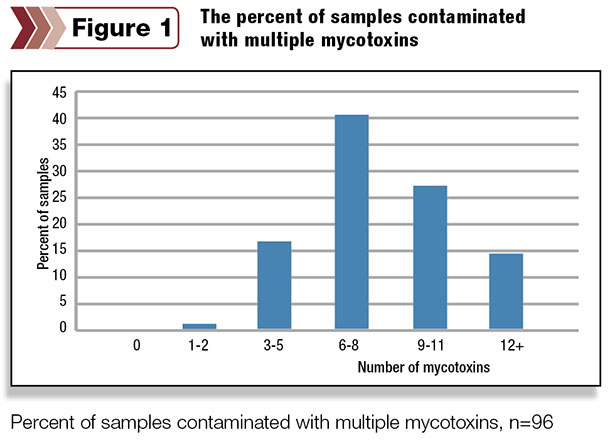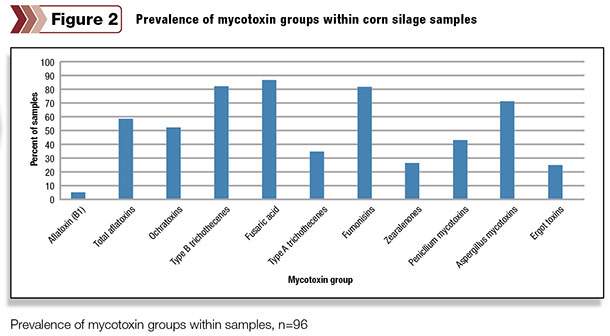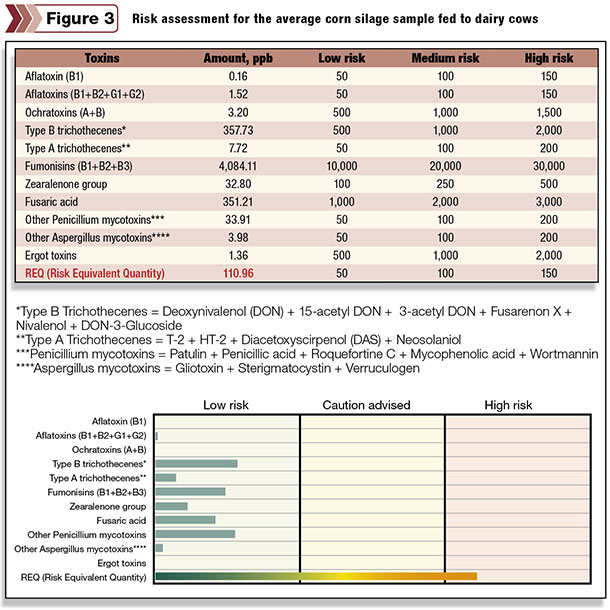As 2013 corn silage is beginning to be more widely fed, producers need to be aware of the findings from a recent U.S. harvest analysis and the impact it may have on herd health and performance. We recently conducted a harvest analysis survey for corn silage and various grains to identify which mycotoxins are present and their levels of concentration in this year’s crops. The analysis was utilized to identify which of a possible 38 mycotoxins were present in each sample.
As shown in Figure 1 , all corn silage samples contained mycotoxins, and 99 percent contained multiple mycotoxins, while 83 percent contained six or more toxins. The presence of multiple mycotoxins can be very harmful to production. Even though they may be low enough to not exhibit the dramatic effects producers look for, they can still lower performance and health, robbing profitability.

Type B Trichothecenes, fusaric acid and fumonisins are the three most prevalent mycotoxin groups across corn silage samples, as demonstrated in Figure 2 . The main impact from these three are that they can decrease dry matter intake, lower milk production, cause gut irritation and lower immune response.

The significance of fusaric acid is that it will act synergistically with Type B Trichothecenes to magnify the effect of Type B Trichothecenes even at lower levels. More than 80 percent of the samples contained all three of the mycotoxin groups.
Considering this information, along with the sensitivity of the dairy cow to these mycotoxins, allows the provision of an overall risk equivalent quantity (REQ), Figure 3 , which considers the total impact that the group of mycotoxins present in samples analyzed is likely to have on the animal.

All mycotoxins are shown to be at low risk, but yet the REQ is approaching high risk. This is due to the number and levels of the mycotoxins present. With a greater number of mycotoxins present, the low levels can work additively and synergistically to increase the total risk.
Most research has been conducted to look at the effects of one mycotoxin at various levels to identify at what level the critical effects take place. The REQ examines multiple mycotoxins as that is what has been identified in the harvest analysis from not only the U.S. but around the world. All analyses showed the greatest percentage of samples contain multiple mycotoxins.
Producers need to be aware that the 2013 corn silage crop is contaminated with multiple mycotoxins, and even at low levels these mycotoxins have a negative effect on cow performance and health. Most mycotoxin problems can go undiagnosed due to lack of perseverance or a lack of records and analysis that may be used for diagnostic purposes.
The management team at the dairy must be willing to cooperate with each other. One of the most important factors is good record-keeping at the dairy. Documentation of production, breeding and treatment is extremely valuable in this situation. Feed and ingredient analysis records are of the utmost importance in determination of the cause and source of a case of mycotoxicosis.
Below is a checklist of questions dairy producers should consider when trying to troubleshoot if a herd may have been affected by mycotoxins:
1. Are your veterinarian and nutritionist currently involved in trying to determine the problems?
2. What are the visual symptoms of the animals?
3. What production and reproduction parameters are below normal expectations?
4. Have any animals died? If so, did the attending veterinarian perform necropsies and send tissue samples to the diagnostic laboratory for evaluation?
5. Have all feed ingredients been tested for any of the following: mold count, yeast count, mold identification and toxin screening?
6. Has the source of water on the dairy been tested for bacteria counts and mineral content?
7. Has the nutritionist reviewed the ration on paper and the physical ration in the bunk for nutrient specification accuracy?
8. Is the vaccination program complete and under direct supervision by the attending veterinarian?
9. Has any diagnostic work been performed by a veterinarian? If so, what was it?
10. How long has the problem been affecting the herd?
11. Did the symptoms have an acute onset? Is this a chronic situation?
It is not uncommon to take immediate measures at the dairy before the diagnostic process is completed. In many cases, the need for immediate results is necessary in an effort to try to resume normal production, reproduction and health status of the affected herd.
In some instances, the actions taken at this point are the determining factor in diagnosing whether or not mycotoxins were a problem in the first place. To address any challenge, a thorough mycotoxin management program needs to be employed. PD
Max Hawkins holds a Ph.D. in animal science from the University of Tennessee and currently serves as a nutritionist on the Alltech mycotoxin management team.
References omitted due to space but are available upon request. Click here to email an editor.

Max Hawkins
Nutritionist
Alltech







